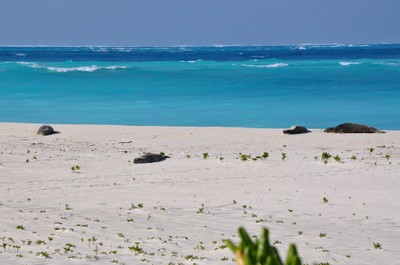The fringe reef and beach were our classroom as we shadowed schools of tropical fish and cut down ironwood trees.
With John Miller from US Fish and Wildlife at the helm, the group made its ways out to the fringe reef of the atoll for our second day of snorkeling. It’s a short 15 minute boat ride from the harbor on Sand Island, but it is truly another world.
As a boy raised in the mid-latitudes, with cold, murky, algae-rich ocean water to swim in, the Midway’s reef never gets old. The azure blue water was crystal clear and reef was overflowing with fish. I’ve studied coral reefs and tropical fish before – and seen them at various aquariums across the US – but to be out in the middle of the Pacific ocean, at the northern most extent of coral, is an unbelievable learning experience, one that I will never forget.
The group paired off and we made our way over the purple and yellow coral in search of fish …. and let me tell you, we were not disappointed! Over the course of an hour and a half, we saw numerous parrot fish (I counted 15 in one school), convict tangs (too many to count!), goatfish, surgeon fish, wrasse, unicorn tang, several jack and even a hungry green sea turtle. Such a huge diversity of fish – endlessly captivating and unbelievably beautiful!
At one point, I stumbled upon a cleaning station where small wrasses were eating parasites off larger fish. This might be an everyday occurrence here in Midway – and at other coral reefs across the globe – but I had never seen it before. I was transfixed, staring as the small wrasse poked and prodded the larger fish – getting its daily meal and cleaning its neighbor.

In the afternoon, we hit North Beach. However, only the monk seals got a chance to relax. With small saws and spray bottles of blue herbicide in tow, we canvassed the naupaka plants and dunes in search of the invasive ironwood tree (Casurina equisetifolia). Introduced to the island at the turn of the century as a means of controlling blowing sand, the tree spread quickly and has been crowding out the native plants, such as the bunch grass and naupaka.

We didn’t have to search far to find a large stand of ironwoods. However, the trees were no match for the Nicholas School! Careful not to step on bonin petrel nests or disrupt laysan albatrosses, we cut down and rooted out as many ironwoods as possible. We had it down to an art: one person cut down the tree, another hauled it off to form a big pile, and finally a third person sprayed or painted the stump with the herbicide to prevent the tree from returning. With 12 volunteers the job went quickly.

The US Fish and Wildlife has a daunting task. Ironwoods are found across Sand Island (although they have been removed from Eastern Island), they spread quickly and grow quite large. With limited staff and volunteers, they have to proceed carefully. They have to prioritize areas and times for clearing ironwoods to ensure that they can manage invasive species over the long-term. While visitors may come to Midway for a week-long stint, the Refuge managers need to ensure that the staff and volunteers can maintain the areas and prevent the reseeding of the ironwoods over the long-term. In a sense, having intermittent visitors work to eradicate invasive species can be a curse in disguise if the staff lacks the manpower and funding to sustain the work of the visitors into the future.
After a long day underwater and on the beach, the group spent the evening at the Midway Bowling Lanes. That’s right – we may be several thousand miles from civilization, but there is a 12 lane bowling alley down the street! It makes sense – the Navy used to have 5,000 people stationed here. I was exhausted after our full day outside and fell asleep on the seats lining the lanes, but I hear people had a fun time launching the heavy balls towards ten wooden pins.
With the ocean and coast as our classroom, there is always something new to learn. I am constantly amazed – each day we work hard, learn a lot and try to give back to this amazing place!
** Photo Credit: Dani Crain
